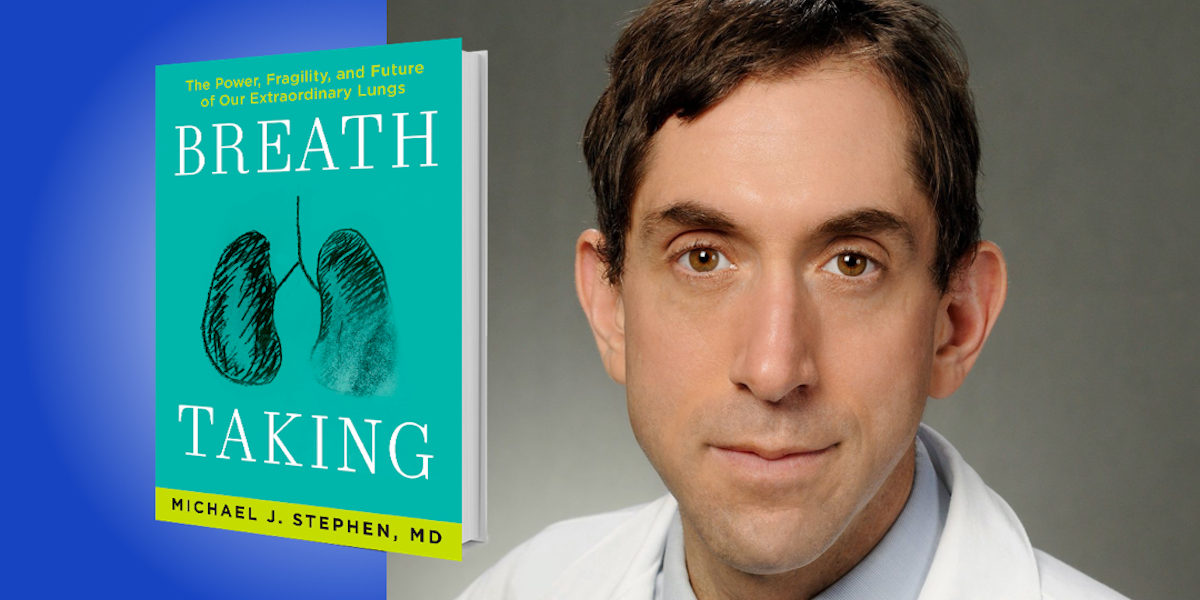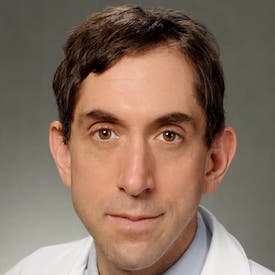Dr. Michael J. Stephen is an associate professor at Thomas Jefferson University in Philadelphia, and director of the Adult Cystic Fibrosis Center. He is a leader of numerous clinical trials and was on the front line caring for COVID-19 patients. Over the past two decades he has studied advanced end-stage lung diseases and worked with patients at diverse locales, including a Massachusetts prison hospital and a pediatric HIV clinic in Cape Town, South Africa.
Below, Michael shares 5 key insights from his new book, Breath Taking: The Power, Fragility, and Future of Our Extraordinary Lungs (available now on Amazon). Download the Next Big Idea App to enjoy more audio “Book Bites,” plus Ideas of the Day, ad-free podcast episodes, and more.
1. The lungs are a physiological miracle.
We take some 20,000 breaths a day, moving 10,000 liters of air in and out of our chest. Our normal resting ventilation rate is five liters per minute, but we can increase this to an astonishing 20 to 30 liters per minute during exercise. This is all made possible by our conducting airways, which moisten and transport the air to our alveoli, the grape-like clusters where gas exchange occurs. If placed end-to-end, our conducting airways would cover 1,500 miles, the distance from New York City to Chicago and back again. And our alveoli, if stretched out, would cover an entire tennis court. While gas exchange is occurring, the lungs are also working to keep toxins out of our system. The defenses of the lung are tremendous, starting at our nose which filters and warms the air, to the tiny hairlike cilia of our conducting airways that beat constantly to move out toxins, to the white blood cells that hunt and attack bacteria and viruses.
2. Our lung health has recently been ignored.
There has been a precipitous decline in lung health over the past fifty years. Between 1980 and 2014 in the United States, there was a 30 percent increase in respiratory diseases, while all the other major causes of mortality declined. Globally the story is much the same, as respiratory diseases are the number three cause of mortality worldwide. Lower respiratory tract infections are the leading cause of mortality in low-income countries, and asthma rates in the U.S. have increased from 3 percent in 1980 to over 8 percent today. Lung cancer is the number one cancer killer worldwide; each year it claims about the same number of lives as the next three cancers combined.
“When the Buddha told us to focus on our breath for health and insight, he was absolutely right.”
Furthermore, the quality of our air has recently declined in the United States. In 2020, it was estimated that 150 million people, or 46 percent of the population, are exposed to air quality that does not meet World Health Organization standards. Globally the situation is even worse, with 91 percent of the world’s population exposed to toxic air, which claims eight million lives each year.
3. The lungs have a tremendous ability to heal us.
Siddhartha Gautama, commonly known as the Buddha, was born in India in the 5th century BCE. At the age of 35, he started a personal quest of breath work to achieve a state of nirvana. Today, we are unraveling the many health benefits that he was already aware of thousands of years ago. In studies of asthma patients, breath work helps them cut back on using inhaled steroids while feeling better and gaining improved exercise capacity. Clear benefits for patients with depression, anxiety, and post-traumatic stress disorder have been shown. Studies have shown breathing exercises may improve diabetes, help us lose weight, and even help us live longer.
The physiology behind why this is true likely goes back to our autonomic nervous system. The vagus nerve, which travels to our diaphragm, is a potent inducer of the parasympathetic branch of our nervous system, which helps us “rest and digest.” Through easy, deep, and effective breaths, our vagus nerve sends signals to our brain that all is right in the world. The brain then releases hormones like dopamine and serotonin, our feel-good hormones that help us regulate our body and its resting functions. So when the Buddha told us to focus on our breath for health and insight, he was absolutely right.
“It should be a universal right to breathe clean air.”
4. There is hope for fighting lung diseases and improving air quality.
There have been many recent hard-fought victories for lung health. A cystic fibrosis patient was expected to live just a few years in the 1950s, but now has a life expectancy of about 50. Smoking rates are down from a high of over 40 percent in the 1960s to less than 15 percent today. Lung cancer deaths have shown a slow but noticeable decline the past few years. Sudden deaths from asthma are down. We perform almost 3,000 life-saving lung transplants in this country every year, while in 1990 this number was just 200. It should be a universal right to breathe clean air, and in order to combat the next inevitable crisis, we must continue to unravel the mysteries of this mystical organ that stands on the front line between us and the atmosphere.
5. There is much you can do to take care of your lungs.
The most obvious of these is to stay away from known toxins and pollutants, like tobacco smoke. Quitting smoking isn’t easy, but nicotine replacement products can certainly help. When pollution levels are high, it’s good to avoid going outside. Outdoor air quality meters are now a built-in function of the weather app on many smart phones, so this is something you can follow easily. Indoors, the humidity should be kept between 30 and 50 percent, and allergens kept to a minimum. Making sure air quality at work is healthy can be difficult, but if you work at a job where dusts are routinely produced, make sure to investigate if those dusts are potentially harmful, and what can be done to minimize personal exposure with an appropriate mask or avoidance. A radon test in the home is a good idea, as this is a known cause of lung cancer. One positive thing to emerge from COVID-19 is the widespread use of masks, which can be used when pollution or allergens are high. Committing to an exercise program that strengthens the muscles of the chest and diaphragm can also go a long way to improved breathing.
For more Book Bites, download the Next Big Idea App today:

































